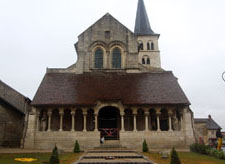Hermonville (Marne, France) - Saint-Sauveur
- Disclaimer
The dating found here is based on the work of John James, and is meant on this site to serve as a starting point. James' dating is derived from a system that uses his interpretation of the development of capitals over time as the basis for chronology, among other factors. His goal is to refine the dating to within years rather than decades. I have not fully embraced James' methodology, and will be developing this page from its current state to one which is admittedly more conservative. The relative expenditure values found in the Timeline are also based on James' work, and I believe these to be reasonably reliable. They are intended only to give a sense of the amount of work involved in each decade.
I have added the idea of the "project" as a way of separating work in buildings. In my mind, a "project" is a discrete section of work in a building that resulted from the one-time acquisition of funding. "Projects" are generally separated by at least a decade where no work was being done. It is my view that it would have been unwise to start a "project" that could not be finished and protected from the elements, and as such a "project" usually involved a wing or multiple wings of a building, from floor to roof. Rural churches, which could only secure small amounts of funding at irregular intervals, often were the result of many small projects, while the great churches, which benefitted from relatively consistent funding, may have involved only a few large projects.
I have added the idea of the "project" as a way of separating work in buildings. In my mind, a "project" is a discrete section of work in a building that resulted from the one-time acquisition of funding. "Projects" are generally separated by at least a decade where no work was being done. It is my view that it would have been unwise to start a "project" that could not be finished and protected from the elements, and as such a "project" usually involved a wing or multiple wings of a building, from floor to roof. Rural churches, which could only secure small amounts of funding at irregular intervals, often were the result of many small projects, while the great churches, which benefitted from relatively consistent funding, may have involved only a few large projects.
- Timeline with Relative Expenditure (if available, in building units)
 |
 |
 |
- Project A - 1130s - Phase 1 - tower base
Tower support and to completion, date uncertain
- Project B - 1150s - Phase 2 - porch
Footings for walls for apse and two chapels for ribs, heavy shafts; wall continues around north transept to nave entry, but cant tell on south, but with the tower nearby probably did both sides
- Project B - 1150s - Phase 3 - e crossing
East crossing piers with mismatch evidence in the respond arches at the level of the capitals, but as there are too many replacements in the bases and plinths to determine exactly what was the original plan, and as well tori often overlap the bases.
- Project B - 1150s - Phase 4 - apse (a)
Apse capitals and chapel vaults
- Project B - 1150s - Phase 5 - w crossing (b)
Footings for west crossing, no rib vaults (aisle shafts added), octagonal shaft across entry, and may have included footings for nave as piers overhang lowest courses.
- Project B - 1150s - Phase 6 - nave (a)
Nave piers, and aisles for ribs, west wall and W-w door with rectangular pilasters; soffits over arcade with piers
- Project B - 1160s - Phase 7 - apse (v)
Apse vault and caps with east side of crossing caps and decision for pointed barrel vaults over transepts, start of crossing arches and vault.
- Project B - 1160s - Phase 8 - nave (c)
Clerestory to nave, completion of crossing vault.
- Project B - 1160s - Phase 9 - porch
Porch
